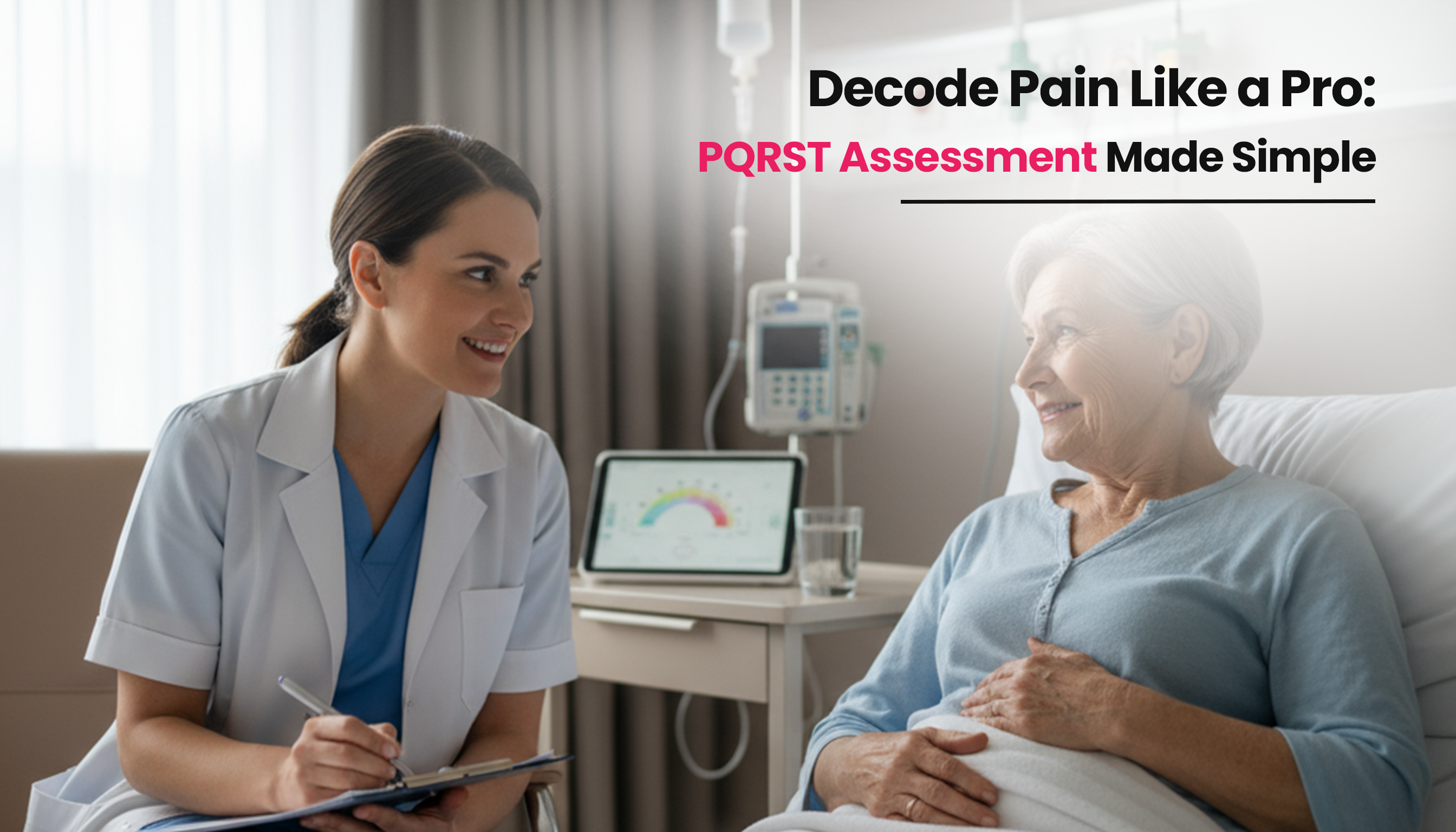When a patient shows up with pain, just asking, does it hurt? It is not enough. Pain comes in different forms, and it is the nurse’s duty to dig deeper and understand what kind of pain it is: sharp, dull, throbbing or stabbing. There is a systematic way to figure out what’s really going on. The PQRST pain assessment tool helps nurses to ask the right questions of patients to assess their pain. Before we discuss what the PQRST assessment tool is, explore the top-paying travel nurse jobs on SkillGigs- where you meet your true match!
What is PQRST pain assessment?
PQRST pain assessment is a systematic approach that healthcare professionals and nurses use to evaluate a patient’s pain. When nurses ask patients, Does it hurt? The simple answer “yes” cannot help nurses understand what is going on. Nurses and healthcare professionals have to dig deeper to understand the quality, severity and impact of the pain, which is important for proper treatment of the patient.
What does PQRST stand for?
PQRST pain assessment is a mnemonic tool that is used to understand patients’ pain in detail to provide better treatment. Each alphabet stands for the following:
- P (Provocation or Palliation)
- Q (Quality or Quantity)
- R (Region or Radiation)
- S (Severity)
- T (Timing)
P (Provocation or Palliation):
Provokes: What is causing the pain and what worsens it?
Palliates: What makes the pain better and relieves it?
Example: My legs hurt when I’m walking (provocation) and it is better when I’m sitting down (Palliation).
Q (Quality and Quantity):
What type of pain is it? Nurses should let the patient answer this question first in their own words and then give them descriptive terms such as Throbbing, Stabbing, Dull, or Sharp to understand better. This question helps nurses understand what type of pain it is.
Example: Patients have a throbbing pain in their head which indicates migraine.
R (Region or Radiation):
Where is the pain located? This question helps the nurses to indicate the location of the pain.
Example: Patients say that the pain starts in their chest and radiates to the left arm. This helps the nurses evaluate that it might be a cardiac condition.
S (Severity):
What is the severity of your pain? How would you rate it on a scale of 0 to 10 (0 indicates no pain and 10 indicates severe pain)? Nurses can also ask questions that “Does it stop you from daily activities?”
These questions help the nurses identify the severity and seriousness of the patient’s condition.
Example: Initially, the pain was 7, but after taking medication, it is 3.

T (Timing):
When does it start? How long does it last and is it continuous or not?
These questions help nurses indicate the timing of the pain and pattern and duration help nurses to understand the pain cycle and the potential triggers that have caused the pain. The pattern of pain means it is acute, chronic, or intermittent.
Documentation example of PQRST pain assessment
Patient reports appendix pain:
- P (Provocation/ Palliative): The pain starts when moving or jumping but is less severe when lying down.
- Q (Quality/ Quantity): Initially, it was dull pain, but it became sharp, stabbing, and severe with time near the belly button area.
- R (Region/Radiation): Started near the naval area and goes down to the lower abdomen.
- S (Severity): It was less severe in the beginning, like 3, but became very severe with time, such as 8 to 10 and made it impossible to do daily activities.
- T (Timming): The pain increased and became continuous with time rather than intermittent and was accompanied by other symptoms such as low-grade fever and nausea.
What are the tips for effective pain assessment?
- Nurses should ask open-ended questions.
- Patients sometimes give nonverbal cues which nurses should observe such as grimacing, restlessness etc.
- Use different assessment methods for children, nonverbal patients, and adult patients. Use age-appropriate communication with patients to understand their pain.
- Use numeric scale, the Wong-Baker FACES Scale and FLACC scale to assess the pain effectively.
- Reassess the pain after medication using the same PQRST method.30 to 60 minutes after medication and 15 to 30 minutes after IV.
Why is PQRST pain assessment important?
- With the help of PQRST pain assessment nurses can identify underlying causes of pain.
- It also promotes patient-centered care and improves communication between patients and nurses.
- It ensures accurate patient documentation and guides treatment and medication decisions.
What does PQRST pain assessment stand for?
PQRST is a systematic approach used by nurses and healthcare providers to assess the pain in the patient. It stands for the following:
P – Provocation or Palliation
Q – Quality or Quantity
R – Region or Radiation
S – Severity
T – Timing
When should nurse perform PQRST pain assessment?
Nurses should perform PQRST pain assessment during initial patient assessment (when admitted to the clinic), suddenly reports a new pain, after giving medications and treatment.
What are the numeric rating scales,the Wong-Baker FACES Scale, FLACC Scale?
- Numeric rating scale: Asking the patient to rate their pain from 0 (no pain) to 10 (severe pain).
- Wong-Baker FACES Scale: Indicating the pain intensity in children and patients with limited literacy through their facial expressions.
- FLACC Scale: assessing pain in non-verbal patients by observing their Face, Legs, Activity, Cry, Consolability.
Conclusion
PQRST pain assessment is a systematic approach used by nurses and healthcare providers to understand the severity, type, location, and impact of pain on patients. PQRST is an effective method that ensures accurate documentation, patient-centered care and better communication. Being a travel nurse is exciting, but to make sure you get high-paying travel nursing contracts, join SkillGigs now. Download our app today and become part of our travel nursing world.







